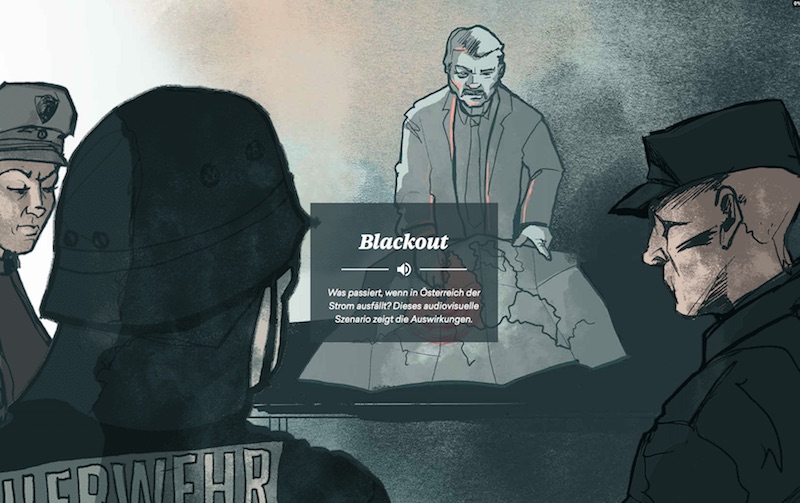Get the weekly SPARTANAT newsletter.
Your bonus: the free E-Book from SPARTANAT.

BLACKOUT (2): Nothing works anymore - the effects of a blackout
The text discusses the severe consequences of a nationwide power outage in Austria. It details the impacts on information and communication technology, transportation, energy supply, water supply, food supply, healthcare, public order, security, and financial damages. The blackout scenario leads to chaos, supply shortages, and potential social unrest. The financial cost of such an event is also explored. Visit ADDENDUM for more information on this important topic.
Numerous studies show that in the event of a nationwide power outage, the entire supply collapses within a few days. Austrian Colonel Gottfried Pausch documented one of the most severe emergency scenarios for the Pinzgau region in a case study. ADDENDUM has visualized this blackout in a multimedia feature. You can view this excellently made multimedia feature HERE.
For Further Reading: The Impacts of a Blackout
- Information and Communication Technology
- In landline telephony, the (digital) devices and subscriber connections immediately fail, followed by local exchanges.
- In mobile networks, it's not so much the devices, which can stay functional for a few days when charged and used moderately, but the base stations that enable network connections. Older technologies are usually overloaded within minutes due to increased call volume or they fail completely because of the short-lived emergency power supply.
- Newspaper publishers and printing houses with emergency power capacities may still contribute to providing information to the public for a short period. Television stations can still broadcast with emergency power supply, but the population can no longer receive TV broadcasts during a power outage.
- Radio broadcasting, which can be received with battery-operated radios (e.g., in cars), becomes the most important source of information for the population during a blackout.
- In terms of communication by authorities and emergency organizations, there will also be significant restrictions after a short period (around 24 hours for digital radio systems, much earlier for conventional radios). The reserves available for central communication facilities are exhausted within a few days at the latest or are largely ineffective due to failed devices.
- Electrically operated elements in road, rail, air, and water transportation fail immediately or within a few hours. Road traffic in cities becomes chaotic immediately after a power outage due to the failure of traffic lights. Intersections, tunnels, and barriers are blocked, resulting in traffic jams and accidents (including those with serious injuries and fatalities). Even rescue services and emergency responders often arrive late at the scene due to the general traffic chaos.
- Lift systems, escalators, electronic locking systems, and door openers fail.
- If overhead lines fail, the electricity-powered rail transportation comes to a halt. Many people can get stranded in subways and trains. Control centers, signal boxes, and safety systems are severely limited in their functions.
- In the realm of aviation, major airports can maintain basic operations for several days with backup power systems and fuel reserves, but takeoffs and landings are limited. Authorities, emergency forces, and relief organizations are extremely challenged in the event of a multi-day power outage: fuel supply must be ensured at least at critical points, detours must be organized, and transportation axes must be defined. Plans for emergency supply of particularly sensitive areas (such as hospitals, nursing homes, etc.) must be in place because otherwise, a blackout leads to chaos within hours.
- Energy Supply
- With the failure of almost all gas stations, numerous vehicles become immobile, and motorized individual transportation decreases significantly within the first 24 hours. Even public transportation struggles to continue operating due to limited fuel, the absence of many drivers, and the prevailing traffic chaos.
- The EU Directive 119/2009, which mandates an emergency power supply at gas stations since 2012, has not been implemented in Austria to this day. Even with self-sufficient power supply at gas stations, the fuel supply could still pose a problem: According to Addendum research, the extraction of fuels from tankers in the petroleum industry is typically secured through a WLAN-based IT system. Without a functioning internet, unloading tankers would not be possible.
- The functionality of emergency power generators is not always guaranteed: According to a German study from 2014, 60% of "emergency power systems" had unusable fuel. The mandatory blending of biofuels in Austria reduces the shelf life of diesel fuels.
- Electric energy is essential for water supply, particularly in water extraction, treatment, and distribution. Without electricity, groundwater extraction becomes impossible. Distribution systems can only be fed by natural gravity, providing considerably less water and leaving higher-altitude areas mostly without supply. Water treatment plants do not function at all without electricity.
- According to the "Ernährungsvorsorge Österreich" study, about 1.5 out of 8 million people in Austria have no water reserves.
- An interruption in water supply significantly impacts the daily lives of people:
- Preparing food and beverages becomes challenging, toilet flushing doesn't work, and personal hygiene is severely limited. As the power outage continues, the problems are expected to worsen.
- Access to clean clothing diminishes, and hygiene conditions become hazardous. Toilets get clogged, increasing the risk of disease spread.
- Wastewater management is also limited during a blackout. Lack of backup power for wastewater pumps can lead to sewage overflowing from the channels and flooding basements. Large amounts of wastewater must be diverted before reaching the sewage treatment plant, flowing into surrounding water bodies. This eventually causes significant environmental damage.
- Another consequence of a power outage is an increased risk of fires: in industrial settings due to cooling and process control system failures, and in households due to attempts to cook, heat, or light without electricity.
- Due to reduced or failed water supply, firefighting becomes more challenging, especially in cities with high population density, increasing the risk of fire spreading to blocks of buildings and even entire neighborhoods.
- Food Supply
- In a blackout scenario, food supply is significantly disrupted, and the adequate provision and distribution of food among the population - especially in rural areas - will primarily be the responsibility of local authorities (municipalities). The successful handling of this situation is crucial not only for the survival of many people but also for maintaining public order and security.
- According to the "Ernährungsvorsorge Österreich" study, approximately three million people will not be able to supply themselves sufficiently within four days of a blackout. This number increases to about six million people after seven days.
- Within the first few days of a blackout, damages occur in greenhouses due to lack of climate control and ventilation, affecting fruits and vegetables.
- The failure of electrically operated animal housing and milking equipment impacts the well-being of animals, initially leading to udder infections in dairy cattle and ultimately death if not treated promptly. The challenge lies in the supply of feed to pigs and poultry in large operations. During a power outage, these animals often die within hours.
- The further processing food industry usually halts immediately, disrupting deliveries to retail stores (following the "just in time" principle). Although these stores hold food stocks, they primarily consist of perishable products. Only a few warehouses can maintain the necessary emergency power supply for more than two days.
- Due to the largely collapsed transport logistics, handling and supply delivery to stores cease. As a result, shelves in stores empty quickly.
- Support for the urban population through small-scale agriculture somewhat functioned in the 1950s. At that time, about one-third of the population in Austria worked in over 430,000 agricultural and forestry enterprises. Today, the situation is different: industrial food production has led to lower food costs but also to a concentration of production. There are currently only 160,000 agricultural and forestry enterprises in Austria.
- Almost all facilities providing medical and pharmaceutical care for the population depend directly on electricity. The healthcare system can only withstand the consequences of a blackout for a short time. Within a few days, the situation worsens to the extent that even with intensive use of regional emergency capacities, the near complete collapse of medical and pharmaceutical care is anticipated.
- Hospitals can only maintain operations to a limited extent with emergency power generators. Medications become scarce, as delivery services fail and the overall production and distribution of pharmaceutical products decline. The insulin supply dependent on the cold chain, and the maintenance of dialysis facilities, is critical. External services such as cleaning, laundry, and food delivery cease.
- Nursing homes may need to evacuate residents partially and release them for home care. Mobile home care services can hardly be sustained. Most medical practices and pharmacies cannot operate without power and will close during a blackout.
- Public Order and Security
- The chaotic conditions during a blackout and the resulting supply shortages could prompt individuals to engage in theft and robbery. Those unable to purchase dwindling food supplies may resort to theft of money and food. Police and military forces reach their limits after several days in maintaining order and security in the country. Many people will leave hotspots (e.g., troubled neighborhoods) and move to relatives, friends, and acquaintances where safety is better guaranteed.
- Correctional facilities with emergency power supply can initially maintain the main functions of their operations during a blackout, namely securing prisoners and providing basic care. Outdoor activities become increasingly problematic, as do extended confinement of inmates. The mental strain rises for both correctional officers and prisoners. Due to traffic issues, correctional officers may arrive late or not at all for duty. This raises the risk of unrest in penitentiaries.
- During a blackout, especially in urban areas, severe riots and violent confrontations on the streets are expected. Coordinating necessary countermeasures is hindered by the breakdown of communication means. Police and military forces will be occupied with maintaining order and security, as well as protecting critical infrastructures, leaving them very limited for other assistance.
- Financial Damages
 The financial consequences of a blackout are also severe: According to the Black Ö.2 study by the Austrian Security Research Promotion Program KIRAS (an initiative of the Federal Ministry for Transport, Innovation and Technology), one hour of blackout costs around 46 million euros in Austria. The damages from a supply interruption scenario analyzed in the study, lasting 25 hours in January with an outage starting at 10 am, amount to approximately 984 million euros for all Austrian companies, public institutions, and households. This includes the reduction of the usual value creation during these working days as well as damages to private households due to loss of benefits, comfort, and direct damages (e.g., spoiled food).
The financial consequences of a blackout are also severe: According to the Black Ö.2 study by the Austrian Security Research Promotion Program KIRAS (an initiative of the Federal Ministry for Transport, Innovation and Technology), one hour of blackout costs around 46 million euros in Austria. The damages from a supply interruption scenario analyzed in the study, lasting 25 hours in January with an outage starting at 10 am, amount to approximately 984 million euros for all Austrian companies, public institutions, and households. This includes the reduction of the usual value creation during these working days as well as damages to private households due to loss of benefits, comfort, and direct damages (e.g., spoiled food).
ADDENDUM Article Series on Blackout in Austria:
The Introduction on SPARTANAT: Austria Practices the Blackout
Part 1: It Will Be Very Difficult to Maintain Control
Part 2: Nothing Works Anymore - The Impacts of a Blackout
Part 3: Land Without Power - Possible Causes for a Blackout
This article was first published on ADDENDUM. Copyright Text: ADDENDUM. Images: ADDENDUM. Video contributions, graphics, and audio contributions: ADDENDUM.
ADDENDUM Online: www.addendum.org
SPARTANAT is the online magazine for Military News, Tactical Life, Gear & Reviews.
Send us your news: [email protected]
Ad
similar
Get the weekly SPARTANAT newsletter.
Your bonus: the free E-Book from SPARTANAT.






